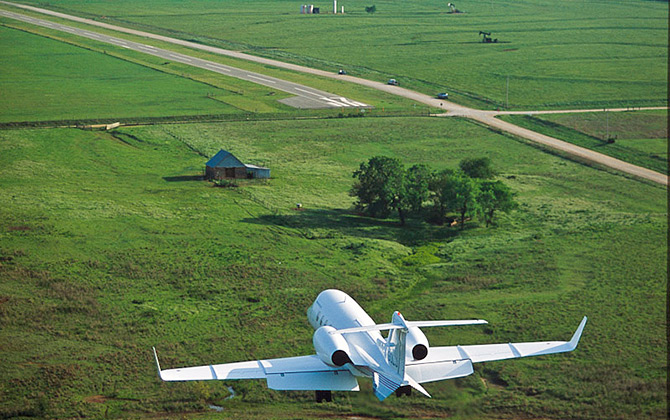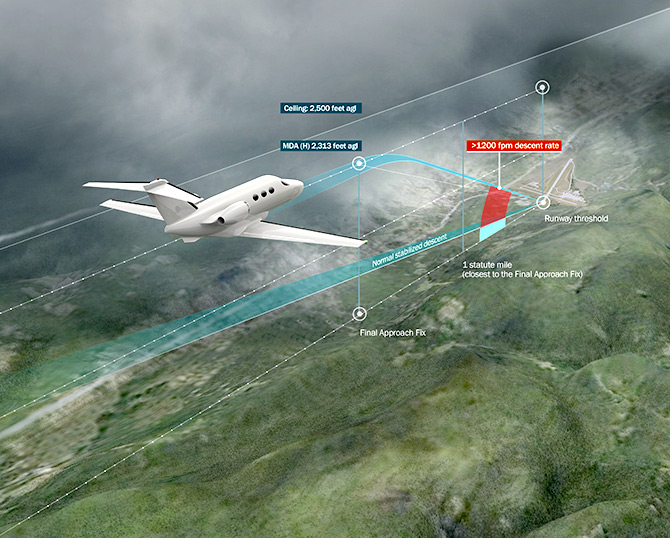(Not) straight-in
Approaches that aren't what they seem to be

By the time they fly their first jet, most pilots are accomplished at instrument flying. They certainly understand the difference, for example, between a straight-in and circling approach. If the final aligns with the runway within 30 degrees, the approach is a straight-in, right?
September 2011
Turbine Pilot Contents
Unfortunately, when flying an aerodynamically clean airplane such as a jet, on some approaches the line between straight-in and circling can be blurred. In jets it is of critical importance to maintain a stabilized approach to the runway, defined in part as a descent rate of no more than 1,000 fpm and airspeed within 10 knots of final landing speed. Because of this, when weather is at or near minimums, there are some nominally straight-in approaches that can really be flown only as a circling approach.
These approaches typically exist in mountainous areas where terrain requires a steep descent angle between MDA and the runway. The geometry of the approach may make it impossible to fly the approach straight-in from minimums, yet straight-in minimums are published.
As an example, look at the RNAV (GPS) Runway 1 approach into Rutland, Vermont (RUT). The majority of pilots to whom I show the approach don’t catch the steep angle required to the runway from MDA. If I ask them, “Winds are from the north, the ceiling is 2,500 feet, visibility is two miles, are we likely to get in flying this approach?” most will look over the minimums and answer yes. Most light jets fly final at about 100 knots and use Category B minimums, which for this approach are 2,313 feet and 1.5 miles.
Looking at the minimums more closely it becomes apparent that the stated weather will make it impossible to land straight in. Because there are no approach lights for Runway 1, the first piece of the airport a pilot will see is the runway itself; if visibility is two statute miles, he will be on a two-mile final when able to descend from MDA. That MDA is 2,313 feet above the runway, so to descend to touchdown would require a gradient of more than 1,200 feet per nautical mile.
 As a normal ILS descends 300 feet per nautical mile, this clearly is going to result in a pretty uncomfortable angle. Even at a low approach speed and with a very strong headwind, a descent rate of 1,400 fpm or more would be required, well outside the acceptable parameters for a stabilized approach. The only option left for the pilot is to complete a full 360-degree circling procedure, entering the upwind over the runway. As long as the pilot can maintain visual terrain clearance, the descent can begin during the circling procedure, so that as the aircraft turns final it is at a more appropriate altitude relative to distance from the runway.
As a normal ILS descends 300 feet per nautical mile, this clearly is going to result in a pretty uncomfortable angle. Even at a low approach speed and with a very strong headwind, a descent rate of 1,400 fpm or more would be required, well outside the acceptable parameters for a stabilized approach. The only option left for the pilot is to complete a full 360-degree circling procedure, entering the upwind over the runway. As long as the pilot can maintain visual terrain clearance, the descent can begin during the circling procedure, so that as the aircraft turns final it is at a more appropriate altitude relative to distance from the runway.
There are a few catches here, however. Most jets fly circling approaches at a flap setting and speed different from those used for a straight-in approach. This speed is usually fast enough to push the operation up a category relative to minimums. For an aircraft flying the RNAV 1, Category C minimums require visibility of three miles—leading to a Catch-22 when the visibility is at the stated two miles; the pilot can’t descend straight in, but also can’t conduct a circling approach. The result is that a prudent pilot wouldn’t commence the approach with visibility less than three miles.
The autopilot modes used for a level-off at MDA may be different from those used for a straight-in. And most important, the pilot must have mentally briefed and prepared for a circling operation. All the above differences in approach execution require prior briefing. Arriving at MDA is no time to turn a straight-in approach into a hasty circle.

When is a "straight-in" approach inadvisable? When a steep descent rate can make for an unstable arrival on short final. In the case of the RNAV GPS Runway 1 approach to the Rutland, Vermont, airport (above, left), you'll probably have to circle to land when visibilities are low. The illustration (above) shows the problem in 3-D.
Neil Singer is a Master CFI and a mentor pilot in Cessna and Embraer jets.


